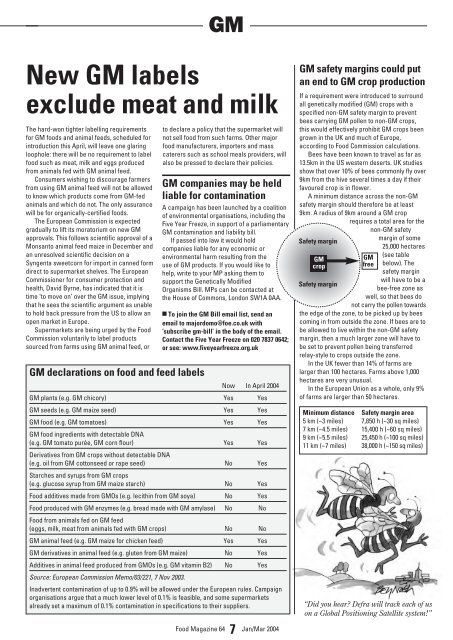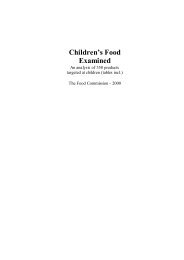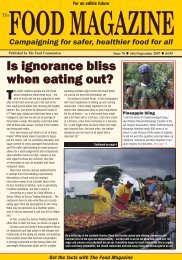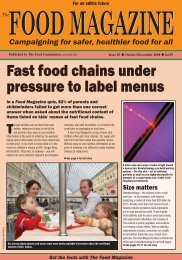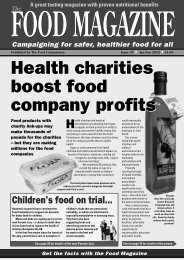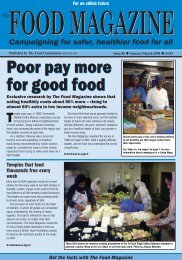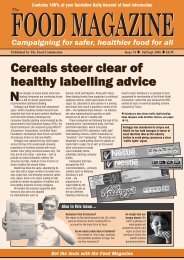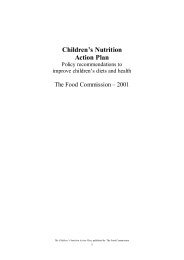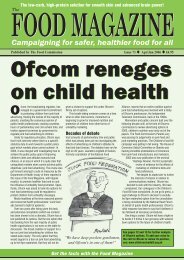Soft drinks - The Food Commission
Soft drinks - The Food Commission
Soft drinks - The Food Commission
- No tags were found...
Create successful ePaper yourself
Turn your PDF publications into a flip-book with our unique Google optimized e-Paper software.
GMNew GM labelsexclude meat and milk<strong>The</strong> hard-won tighter labelling requirementsfor GM foods and animal feeds, scheduled forintroduction this April, will leave one glaringloophole: there will be no requirement to labelfood such as meat, milk and eggs producedfrom animals fed with GM animal feed.Consumers wishing to discourage farmersfrom using GM animal feed will not be allowedto know which products come from GM-fedanimals and which do not. <strong>The</strong> only assurancewill be for organically-certified foods.<strong>The</strong> European <strong>Commission</strong> is expectedgradually to lift its moratorium on new GMapprovals. This follows scientific approval of aMonsanto animal feed maize in December andan unresolved scientific decision on aSyngenta sweetcorn for import in canned formdirect to supermarket shelves. <strong>The</strong> European<strong>Commission</strong>er for consumer protection andhealth, David Byrne, has indicated that it istime ‘to move on’ over the GM issue, implyingthat he sees the scientific argument as unableto hold back pressure from the US to allow anopen market in Europe.Supermarkets are being urged by the <strong>Food</strong><strong>Commission</strong> voluntarily to label productssourced from farms using GM animal feed, orGM declarations on food and feed labelsto declare a policy that the supermarket willnot sell food from such farms. Other majorfood manufacturers, importers and masscaterers such as school meals providers, willalso be pressed to declare their policies.Now In April 2004GM plants (e.g. GM chicory) Yes YesGM seeds (e.g. GM maize seed) Yes YesGM food (e.g. GM tomatoes) Yes YesGM food ingredients with detectable DNA(e.g. GM tomato purée, GM corn flour) Yes YesDerivatives from GM crops without detectable DNA(e.g. oil from GM cottonseed or rape seed) No YesStarches and syrups from GM crops(e.g. glucose syrup from GM maize starch) No Yes<strong>Food</strong> additives made from GMOs (e.g. lecithin from GM soya) No Yes<strong>Food</strong> produced with GM enzymes (e.g. bread made with GM amylase) No No<strong>Food</strong> from animals fed on GM feed(eggs, milk, meat from animals fed with GM crops) No NoGM animal feed (e.g. GM maize for chicken feed) Yes YesGM derivatives in animal feed (e.g. gluten from GM maize) No YesAdditives in animal feed produced from GMOs (e.g. GM vitamin B2) No YesSource: European <strong>Commission</strong> Memo/03/221, 7 Nov 2003.GM companies may be heldliable for contaminationA campaign has been launched by a coalitionof environmental organisations, including theFive Year Freeze, in support of a parliamentaryGM contamination and liability bill.If passed into law it would holdcompanies liable for any economic orenvironmental harm resulting from theuse of GM products. If you would like tohelp, write to your MP asking them tosupport the Genetically ModifiedOrganisms Bill. MPs can be contacted atthe House of Commons, London SW1A 0AA.■ To join the GM Bill email list, send anemail to majordomo@foe.co.uk with‘subscribe gm-bill’ in the body of the email.Contact the Five Year Freeze on 020 7837 0642;or see: www.fiveyearfreeze.org.ukInadvertent contamination of up to 0.9% will be allowed under the European rules. Campaignorganisations argue that a much lower level of 0.1% is feasible, and some supermarketsalready set a maximum of 0.1% contamination in specifications to their suppliers.GM safety margins could putan end to GM crop productionIf a requirement were introduced to surroundall genetically modified (GM) crops with aspecified non-GM safety margin to preventbees carrying GM pollen to non-GM crops,this would effectively prohibit GM crops beengrown in the UK and much of Europe,according to <strong>Food</strong> <strong>Commission</strong> calculations.Bees have been known to travel as far as13.5km in the US western deserts. UK studiesshow that over 10% of bees commonly fly over9km from the hive several times a day if theirfavoured crop is in flower.A minimum distance across the non-GMsafety margin should therefore be at least9km. A radius of 9km around a GM croprequires a total area for thenon-GM safetySafety marginGMcropSafety marginmargin of some25,000 hectaresGM (see tablefree below). <strong>The</strong>safety marginwill have to be abee-free zone aswell, so that bees donot carry the pollen towardsthe edge of the zone, to be picked up by beescoming in from outside the zone. If bees are tobe allowed to live within the non-GM safetymargin, then a much larger zone will have tobe set to prevent pollen being transferredrelay-style to crops outside the zone.In the UK fewer than 14% of farms arelarger than 100 hectares. Farms above 1,000hectares are very unusual.In the European Union as a whole, only 9%of farms are larger than 50 hectares.Minimum distance Safety margin area5 km (~3 miles) 7,850 h (~30 sq miles)7 km (~4.5 miles) 15,400 h (~60 sq miles)9 km (~5.5 miles) 25,450 h (~100 sq miles)11 km (~7 miles) 38,000 h (~150 sq miles)“Did you hear? Defra will track each of uson a Global Positioning Satellite system!”<strong>Food</strong> Magazine 64 7 Jan/Mar 2004


